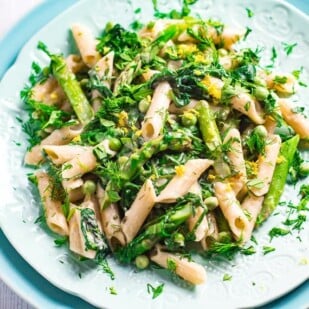
Low FODMAP Pasta Primavera
Our Low FODMAP Pasta Primavera is made in one pan and features low FODMAP, gluten-free penne, loads of arugula and spinach, chives, asparagus, peas, fresh herbs and Parmesan all in low FODMAP portions.
Ingredients:
- 2 tablespoons Onion-Infused Oil, made with shallots and olive oil; extra if needed
- 1/3 cup (24 g) chopped chives or scallion greens
- 3 1/2 cups (840 ml) water
- Kosher salt
- 12- ounces (340 g) low FODMAP, gluten-free penne, such as Jovial brand
- 3 asparagus stalks (50 g), trimmed, cut into 2-inch (5 cm) lengths
- 3- ounces (85 g) fresh baby arugula leaves
- 3- ounces (85 g) fresh baby spinach leaves
- 40 grams frozen peas, about 1/4 cup
- 2 tablespoons unsalted butter
- 3- ounces (85 g) finely grated Parmesan cheese
- 2 tablespoons freshly squeezed lemon juice, plus 1 teaspoon finely grated lemon zest
- 2 tablespoons chopped fresh dill
- 2 tablespoons chopped fresh tarragon
- Freshly ground black pepper
Preparation:
-
Heat the oil over medium heat in a large straight-sided skillet until shimmering (we used a pan 14-inch/35.5 cm wide and 3-inches/7.5 cm deep); you will need a cover for later. Add chives or scallion greens and sauté until soft, but not browned. Add the water, a large pinch of salt and the pasta, stir well, cover and bring to a boil. After 4 minutes add the asparagus and cook for about 30 seconds, then stir the arugula and spinach into the pasta and water. Re-cover the pot. Keep boiling until pasta is a little firmer than al dente. Do not let the water completely evaporate; the dish should look juicy. Stir in the peas and allow to cook for about 30 seconds, just to heat through.
-
Remove from heat; stir in butter, Parmesan, the lemon juice, zest, dill and tarragon. Toss everything together well; if mixture looks dry, drizzle in a little more oil. Taste and season with salt and pepper and serve immediately.
Notes:
Tips
Variations:
• You can add 4-ounces (115 g) prosciutto, torn into pieces, stirred in with the peas
• Add ¼ cup torn fresh basil leaves instead of dill and tarragon
FODMAP Information
Our recipes are based on Monash University and FODMAP Friendly science.
- Cheese: Many cheeses have low FODMAP serving sizes. The low FODMAP diet is not a dairy-free diet. Hard cheeses such as Parmigiano Reggiano or Pecorino Romano have been lab tested by Monash University and are low FODMAP in 40 g amounts.
- Lemon Juice: Monash University has lab tested lemon juice and it is low FODMAP in 1/2 cup (125 g) amounts.
- Onion-Infused Oil: Make your own Onion-Infused Oil or buy a commercial equivalent for the easiest way to add onion flavor to your food. Fructans in onions are not oil-soluble, so onion-infused oil is low FODMAP.
- Pasta: You have to read labels but there are many low FODMAP and gluten-free brands of pasta available. Use what is called for in individual recipes. Our go-to is rice based pasta. Monash University lab tests states that 145 g for 1 cup cooked pasta is a low FODMAP serving and FODMAP Friendly lab testing suggested 2 cups or 146 g cooked is low FODMAP.
- Scallions: The green parts of scallions are low FODMAP as determined by Monash University lab testing and can be used to add onion flavor to your low FODMAP cooking.
Please always refer to the Monash University & FODMAP Friendly smartphone apps for the most up-to-date lab tested information. As always, your tolerance is what counts; please eat accordingly. The ultimate goal of the low FODMAP diet is to eat as broadly as possible, without triggering symptoms, for the healthiest microbiome.